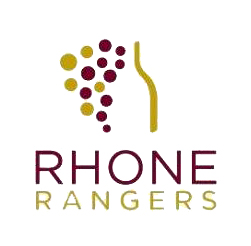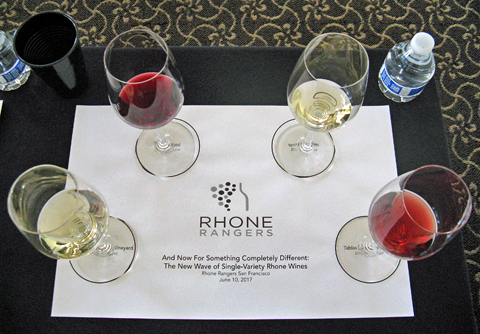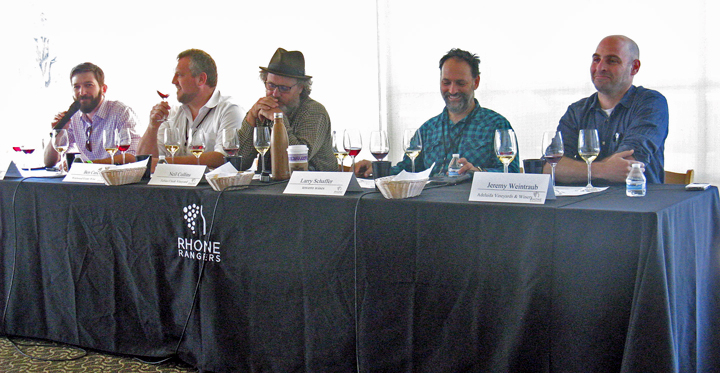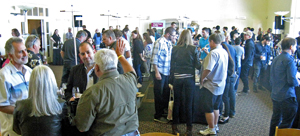Acquiesce
Acquiesce was established in 2012, and owner/winemaker Sue Tipton and her husband Rodney were on hand at the tasting. All the wines are from estate-grown fruit (Tablas clones) and are made entirely in stainless steel. I thought that a couple of the Acquiesce wines I tasted were highlights. The 2016 Grenache Blanc had pear and apple aromas, medium-light mouthfeel and a bright finish. Even better was the 2016 “Belle Blanc” (45% Grenache Blanc, 45% Roussanne, 10% Viognier) with stone fruit, earth, and floral notes, medium weight on the palate, and a lively finish. Acquiesce is setting the bar for fine Rhône-variety whites from Lodi.
Adelaida Vineyards & Winery
Adelaida is located on the Westside of Paso Robles. The first vintages date to the early 1980s and new estate vineyard plantings have continued over the years. Adelaida produces wines from Rhône and Bordeaux varieties as well as Pinot Noir (from their historic HMR Estate Vineyard) and Zin. Winemaker Jeremy Weintraub has been on board since 2012. I tasted the 2015 Picpoul Blanc at the seminar – this featured bright citrus and stone fruit aromas, spice, and zippy acidity on the finish. I tried a few more wines at the Grand Tasting, and one standout was the 2016 Rosé – mostly from Grenache plus Cinsault, Counoise, Syrah, and Mourvèdre, with the component parts made separately and blended before bottling. Fresh red fruits and flowers on the nose, with a bright texture and lively finish. The other highlight was the 2014 Signature Series Anna’s Estate Mourvèdre, with plummy, earthy, and slightly smoky aromas, good structure, and a stony mineral note on the finish. Adelaida has definitely been on the upswing over the past few years.
Brecon Estate
Brecon was launched with the 2012 vintage by two couples, Damian and Amanda Grindley and Simon and Anna Hackett. They purchased an older vineyard in the on the Westside of Paso Robles and remodeled the winery and tasting room – it’s an award-winning architectural design. Damian is the winemaker, and Brecon focuses on Rhône and Bordeaux varieties as well as Albariño. Amanda poured me several of the Brecon wines, and my favorite was the 2015 Estate Syrah. This had beautiful floral and black fruit aromas along with touches of herbs and black olives, medium body on the palate, with lively acidity and moderate tannins.
Domaine de la Terre Rouge
A longtime leader among Sierra Foothills Rhône-style producers, Bill Easton of Terre Rouge poured his wines at the tasting. He founded his winery in Amador County’s Shenandoah Valley in 1994 – prior to that, he owned and ran the well-known Solano Cellars wine shop in Berkeley. I only had a chance to taste a couple of the Terre Rouge wines, but both were noteworthy. The 2016 Vin Gris d’Amador (46% Grenache, 40% Mourvèdre, 7% Roussanne, 7% Grenache Blanc) had bright orangepeel, stone fruit, and spice aromas, medium-light bodied with a clean, fresh finish. The 2010 “L’Autre” (73% Grenache, 14% Syrah, 13% Mourvèdre) featured ripe plum, spice, earth, and a touch of iron, with medium weight and moderate tannins.
Edmunds St. John
Started in 1985 by Steve Edmunds and his wife Cornelia St. John, the winery has moved a few times over the years. The wines are currently produced at the Perry Creek facility in El Dorado County, the region from which Steve sources most of his fruit. Steve has focused mainly on Rhône varieties and blends, along with Gamay Noir. Steve poured three wines at the tasting – 2016 “Heart of Gold” (Vermentino, Grenache Blanc), 2015 “Rocks & Gravel” (Grenache, Mourvèdre, Syrah), and 2013 “North Canyon Road” Syrah. The fruit for “Heart of Gold” comes from Fenaughty Vineyard in the Apple Hill area near Placerville. The “Rocks & Gravel” blend, sourced from Unti Vineyard in Dry Creek Valley, was made entirely with whole clusters and aged in concrete and steel tanks. The Syrah was sourced from Fenaughty Vineyard and nearby Barsotti Vineyard. Steve also had an “under the table” bottle of his pre-release 2016 “El Jaleo” (Grenache, Mourvèdre, Tempranillo, Graciano) from Shake Ridge Ranch in Amador County.
Fields Family Wines
Owner Russ Fields purchased property in the Mokelumne River AVA of Lodi in 2005, and the winery’s estate vineyard includes Syrah, Mourvèdre, Tempranillo, Grenache Blanc, and Vermentino. Winemaker Ryan Sherman poured the wines at the tasting. I thought several of the Fields wines were highlights, starting with the 2015 Bechthold Vineyard Cinsault, from 125+ year-old vines in Lodi. This may have been my favorite Cinsault of quite a few I’ve tried from this vineyard over the years – bright, red-fruited, with herb and wet stone notes, lively acidity and chalky tannins on the finish. The 2016 Estate Syrah, made entirely with whole clusters, had a savory quality along with dark berry fruit, herbs, and a chalky texture. The 2014 “The Roasted Slope” Syrah – co-fermented with 9% Viognier – displayed a distinct floral quality along with spice, plum and darker berry fruit, and a stony mineral note, with a lively mouthfeel and finish. This was my first experience with Fields Family, and it really opened my eyes as to the potential of Syrah in Lodi.
Holly’s Hill Vineyards
Holly’s Hill gets much of its fruit from its two estate vineyards, first planted in 1998 at an elevation of about 2,600 feet in El Dorado County. Tom & Holly Cooper own the winery and their daughter Carrie is the winemaker, while Carrie’s husband Josh Bendick shares in the winemaking duties as well as sales and marketing. There were several noteworthy wines among the Holly’s Hill bottlings I tasted. The 2016 Grenache/Cinsaut Rosé featured intense bright red fruit aromas along with herbs and a floral note, with good acidity and long, pleasant finish. The 2016 Grenache Blanc, with fresh apple and pear on the nose, medium-light texture and a crisp, clean finish, was another winner. The 2015 Estate Mourvèdre showed that variety’s savory, earthy, and iron/mineral side well, with a lively mouthfeel and moderate tannins.
Jaffurs Wine Cellars
Craig Jaffurs launched his label with the 1994 vintage after spending five years at Santa Barbara Winery. He’s focused almost exclusively on Rhône-style wines over the years, with fruit sourced from Santa Barbara County vineyards. Craig poured his wines at the event. I particularly enjoyed the 2015 Thompson Vineyard Grenache Blanc, with its petrol and stone fruit aromas, medium texture, and long finish, and the 2013 Bien Nacido Vineyard Syrah, which displayed lots of black pepper along with dark fruit, spice, good structure and firm tannins – this should develop nicely in the cellar.
Kale Wines
Winemaker Kale Anderson started the Kale label with his wife Ranko in 2008, focusing on Rhône-style wines. He’s worked at high-profile wineries such as Colgin Cellars, Terra Valentine, Cliff Lede, and Pahlmeyer. Red wines are mostly native fermentations in open-top stainless steel and French oak tanks. Ranko was behind the winery table when I stopped by at the tasting. I thought three of the Kale wines were especially noteworthy, beginning with the 2016 Somerston Vineyard Grenache Blanc from Napa Valley, with bright, fresh apple, stone fruit and herb aromas, medium-light texture, and a crisp finish. The 2016 Kick Ranch Rosé, made in stainless steel, featured red fruit and watermelon with floral undertones, and brisk acidity. The 2012 “Home Run Cuvée” (68% Syrah, 30% Grenache, 2% Viognier) from Kick Ranch showed black olive, spice, dark berry fruit, and background notes of sweet oak, with medium weight and moderate tannins.
Ledge Vineyards
Ledge Vineyards’ owner/winemaker Mark Adams was on hand to pour his latest releases. He has an estate vineyard on the Westside of Paso Robles, and all of the fruit he sources for the Ledge wines come from the Willow Creek District AVA where his own vineyard is located. I thought two of the Ledge wines I tasted were particularly noteworthy. My favorite was the 2014 James Berry Vineyard Syrah, with a bright and savory character including grilled meat, spice and dried herbs on the nose, medium weight on the palate and fine tannins. The 2014 “Vineyard Drive” (35% Syrah, 25% Tannat, 20% Grenache, 20% Zinfandel) was also very good, displaying both red and black fruits, plenty of spice, with a bigger structure and firm tannic finish.
|
MacLaren Wine Company
MacLaren was founded in 2007 by Steve and Heather Law, and focuses on cool-climate Syrah. The Syrahs use little or no whole-cluster in their fermentations and are aged in mostly older oak. The winery also produces a little Sauvignon Blanc and Pinot Noir, and recently released their first Viognier. Steve was behind the winery table and poured a strong group of recent releases – I felt several were standouts. The 2016 Viognier is MacLaren’s first release of the variety, from Russian River Valley – it showed citrus and stone fruit aromas with floral undertones, and vibrant acidity. All of the Syrahs displayed a savory character and great acidity. My favorites were the 2013 Atoosa’s Vineyard Syrah – dark fruit and lighter weight for Syrah, with bright mouthfeel and fine tannins – and the 2013 “Drouthy Neebors” Syrah (a blend of vineyards with mostly Atoosa’s fruit) – more herbal with a touch of black olives, more body on the palate, and a bit bigger structure and tannin.
Petrichor
Petrichor (it means “the scent of rain on dry earth”) is the label of Jim Foley and Margaret Bradley-Foley, and their first release was from the 2009 vintage. The estate vineyard is located in the Fountaingrove District AVA above Russian River Valley, and Ryan & Megan Glaab (of Ryme Cellars) make the wine. Petrichor presented a strong wine line-up with several highlights. The 2016 Estate Rosé – from 62% Grenache and 38% Syrah – had fresh red fruit aromas along with notes of flowers and spice, a vibrant texture and clean finish. The 2014 Grenache featured bright strawberry aromas, herbs, and spice, with medium body and firm, chalky tannins. The 2014 “Les Trois” (76% Syrah, 24% Grenache) was quite peppery, with darker fruit, earth, and a hint of flowers, bigger structure, and a stony mineral note on the finish. The name “Les Trois” refers to the Syrah clones included – 877 and 470 – plus Alban clone Grenache.
Qupé
Bob Lindquist was one of the earliest of California’s “Rhone Rangers,” establishing his winery in 1982. 40-acre Sawyer Lindquist Vineyard, in cool Edna Valley, has been biodynamically-farmed since the first plantings in 2005. Bob’s son Ethan was on hand to pour their wines at the event. Qupé always has a strong group of wines on hand, and although I didn’t taste them all, most of the ones I tried were standouts. The 2012 Sawyer Lindquist Vineyard Grenache (88% Grenache, 12% Syrah) displayed bright and fresh red fruit, herbs, and a chalky/minerally mouthfeel and finish. The 2012 Sawyer Lindquist Vineyard “Sonnie’s” Syrah had a savory character, with herbs, lots of pepper, dark berry fruit, and a hint of flowers, good acidity and structure, and refined tannins. The 2011 Bien Nacido Hillside Estate Syrah showed the variety’s meaty, somewhat gamey side, along with spice and blackberry aromas, bigger structure, and firm tannic finish – this should age nicely for many years.
Rune Wines
Rune winemaker James Callahan founded his winery in 2013 in Sonoita, Arizona. He’s worked at a number of wineries in regions as diverse as Napa Valley, Walla Walla, New Zealand, and Russian River Valley. Most of the Rune wines to date have been made from Rhône grape varieties. I’d only tasted one wine from Rune in the past, and their wines I tasted this year at Rhone Rangers – all from Pillsbury Vineyard in Arizona’s Willcox AVA – were some of the best I’ve tried over the years from Arizona. Favorites included the 2015 Grenache, which was loaded with red fruit and spice, plus very good acidity and a lively mouthfeel and finish. The 2015 “Wild” Syrah includes lots co-fermented with Viognier, with Roussanne, and with Malvasia (all with native yeast) – this had a very savory quality along with plummy fruit, spice, and floral undertones, medium body, and moderate tannins.
Skinner Vineyards
Mike and Carey Skinner established their family winery in the Fair Play area of El Dorado County in 2007. They farm two estate vineyards – one at a lower elevation and one at a higher site next to the winery – and source much of their fruit from them. I spotted winemaker Chris Pittenger at the tasting but missed him when I visited the table. I thought the Skinner wine line-up was a strong one, with several standouts. The 2016 Rosé, from Grenache, Mourvèdre, and Counoise, had floral and strawberry aromas and a clean, fresh character, while the 2016 Grenache Blanc featured stone fruit and spice on the nose, and bright acidity in the mouth. Best of all was the 2015 Mourvèdre, a very good example of how distinctive this variety can be from the Sierra Foothills – this one showed earth, black cherry and plum, pepper, iron, and game aromas with a stony mineral quality on the finish, one of the day’s highlights.
Skylark Wine Company
Skylark was founded in 2002 by John Lancaster and Robert Perkins of Boulevard Restaurant in San Francisco. Most of the vineyard sources for the Skylark wines are from Sonoma and Mendocino counties. Robert and his wife Kristine were behind the table for the tasting. The wines were very good across the board, and I had two particular favorites. The 2016 “Pink Belly” is a rosé of Grenache, and had pretty floral aromas along with red fruit and spice notes, with a bright mouthfeel and vibrant finish. The 2013 Rodgers Creek Vineyard Syrah continued Skylark’s string of winners from this vineyard, with dark berry fruit, savory, meaty elements plus a stony mineral component, lively texture and fine tannins – very tasty now but should age very well too.
Tablas Creek Vineyard
Tablas Creek is co-owned by the Perrin family (of Château de Beaucastel fame) and Robert Haas (founder of Vineyard Brands importers). Their 120-acre certified organic estate vineyard on the Westside of Paso Robles was first planted in the early 1990s, and has been farmed using more biodynamic techniques in recent years. Although I almost always stop at the Tablas Creek table at Rhone Rangers, I missed it this year though I did taste their 2015 Terret Noir at the seminar. Light in color with floral red fruit and a stony mineral note, a lively texture and moderate tannins on the finish – quite distinctive.
Tercero Wines
Larry Schaffer started his Tercero label with the 2006 vintage while he was working for Fess Parker Winery – he’s focused on Tercero full-time since 2011. His specialty is wines from Rhône grape varieties sourced from Santa Barbara County vineyards, though he makes a very nice Gewürztraminer and Albariño as well. I tasted the 2014 Marsanne at the seminar – this had lots of spice on the nose, not fruit-forward, with pear and almond notes and a chalky element on the finish, intriguing now but should improve with age. I tried several more Tercero wines at the Grand tasting, and thought the highlights were the 2014 Grenache Blanc, with its stone fruit and mild petrol aromas and lively texture and finish, and the 2016 Mourvèdre Rosé, with bright red fruit, spice and earth notes, and vibrant acidity – one of the best of a very good group of rosé wines at the tasting.
The Withers Winery
Proprietor Andrew Tow was behind the table at the tasting. The Withers focuses on Pinot Noir and Rhône-style wines, which are made in Sonoma County by David Low (of Anthill Farms). Fruit for all of The Withers’ Rhône wines comes from El Dorado County in the Sierra Foothills. Two of the wines were especially noteworthy – the 2014 “Bel Canto” (73% Grenache, 22% Mourvèdre, 5% Syrah), fermented with about 35% whole clusters, displayed strawberry and cherry fruit, flowers, and earth, with medium weight and moderate tannins. The 2014 “Ruben” (82% Mourvèdre, 12% Syrah, 6% Grenache) showed a darker fruit profile with lots of spice, earth, and herbal notes, lively texture on the palate and a stony mineral note on the finish.
Two Shepherds Vineyards
Two Shepherds focuses mainly on wines made from Rhône grape varieties. The wines are made in Sonoma County, and the first commercial vintage was in 2010. Owner/winemaker William Allen was behind his winery table at the event. I only tasted a few of the Two Shepherds wines on this occasion, and I thought the standout was the 2016 Grenache Rosé, from Potter Valley in Mendocino County. This showed red fruit with floral notes, good acidity, and a slightly chalky texture on the finish.
Westwood Estate Wine
Originally founded in the 1980s, the winery has undergone several ownership changes over the years. Their estate Annadel Gap Vineyard, in northern Sonoma Valley, was planted in 2001 to Viognier, Roussanne, Pinot Noir, Grenache, Mourvèdre, Syrah, and Counoise. Ben Cane, formerly with Twomey Cellars, is the winemaker and David Ramey consults. The only Westwood wine I tasted at this year’s Rhone Rangers was the 2014 Estate Counoise, which I tried at the seminar. The aromatics were shy at first but became stronger with more air, with notes of cherry, spice, a savory/meaty element, a framework of sweet oak, and moderately tannic finish.
|





